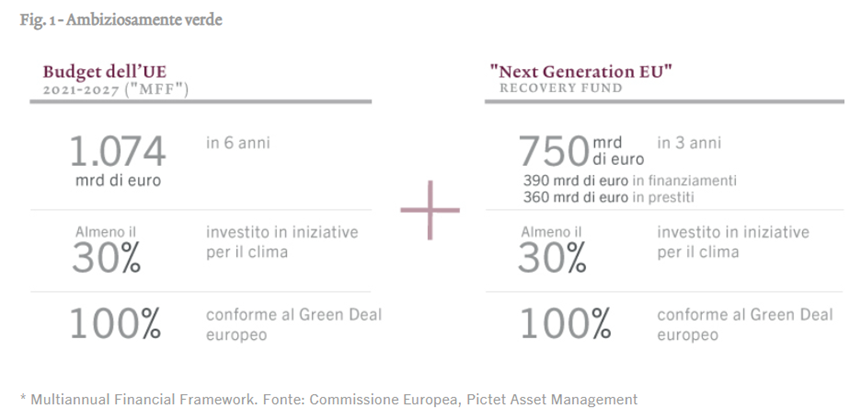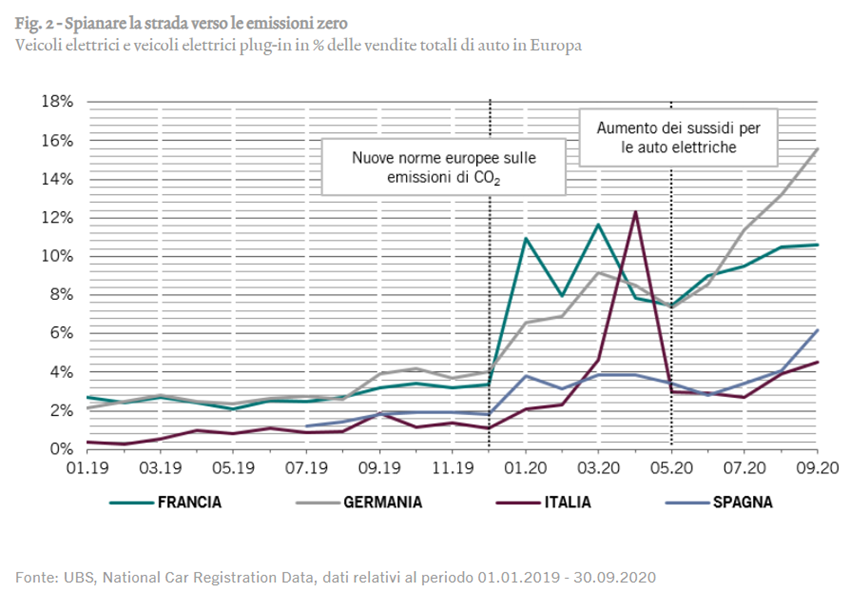I’ll explain the electric and green turn of Europe

Emissions, electric cars and more: Europe raises the bar on clean energy. All the details in the speech by Stephen Freedman, senior product specialist at Pictet Asset Management
Engage the fifth. This is precisely what the European Union has just done, choosing the route towards a more sustainable economy.
Its new climate plan calls for cutting greenhouse gas emissions by 55% from 1990 levels by the end of the decade. A much more ambitious target than previously set by the EU of 40% and means the region could become carbon neutral by 2050. It is not difficult to understand why the EU is so determined to pursue a recovery plan. "Green".
If well executed, the plan will offer the tempting prospect of restoring both the environment and the economy to full health. The funds allocated undoubtedly point in that direction. The package will translate into approximately € 7 trillion of new “green” investments by 2050.
Crucial to the region's economic outlook, a great deal of that money will be channeled into the environmental sector (see Fig. 1), a rapidly growing sector that is making an ever-increasing contribution to GDP. The gross value added of the environmental sector – a measure of its contribution to national production – grew to 286 billion euros in 2015, up 63% since 2003.
This sector, where there are some particularly vibrant companies, such as those involved in resource management and which includes renewable energy and energy efficiency, grew by 150% over the same period.

More generally, the European sector of environmental goods and services can now easily rival that of the United States.
It already employs 4 million full-time workers, up 38% since 2003, and contributed over 2% of the region's GDP in 2015.
ELECTRIC CARS: GREEN TRAFFIC LIGHT
Under this plan, transportation, energy and real estate will undergo a transformation.
Take cars for example: if European governments succeed in meeting their growth and pollution targets, electric vehicles will become a strategic sector.
Here, the approach is that of the carrot and stick.
France has launched an 8 billion euro program to boost the electric car sector, with the goal of producing over 1 million electric and hybrid cars every year over the next five years. The plan also includes a financial incentive that would reduce the cost of purchasing an electric vehicle by up to 40%.
Germany also strengthened its support for zero-emission transport, doubling its contributions to € 9,000, after the previous increase in November 2019. (2)
These incentives have already had a clear impact on the uptake of electric vehicles, whose sales in Germany, for example, grew to 13% of total car sales in August 2020, up from just 2.5% in the same month in August 2020. 2019.
Regulators are also playing an important role. Europe, the second largest market for electric vehicles after China, now has very stringent emissions regulations. Each carmaker must comply with a cap for emissions for its entire fleet set at 95 g CO2 / km on average by the end of 2020 – around 20% below the average emissions level in 2018. This cap will drop to 81g by 2025 and 59g by 2030.
Those who do not comply with these regulations will have to pay a heavy price: the fine is 95 euros for every g / km of excess emissions per vehicle. Car manufacturers that fail to improve CO2 emissions from 2019 levels will therefore face possible fines of several billion euros each year.
All of this will help to further accelerate the growth of electric mobility.

REBUILD BETTER
The construction sector will be equally crucial to the European recovery plan and not just because 70% of all buildings in the region are over 20 years old.
The European Green Deal has reserved approximately 370 billion euros – or 53 billion euros a year – for renovations to increase energy efficiency and “decarbonise” existing buildings. It would be a big boost for the European building renovation sector, which was worth € 819 billion in 2019. (3)
Europe is also proposing a $ 100 billion allocation for research and development (R&D) to be spent in the digital and environmental sectors. The seven-year program, which will be launched in 2021, aims to boost productivity and growth and maintain competitiveness in the sectors that affect the Green Deal objectives. The Commission estimates that every euro invested in R&D will yield 11 euro.
When it comes to sustainability, Europe has raised the bar. Its ambitious spending commitments and stricter regulations not only constitute an environmental model to follow for other countries, but also offer the prospect of more solid economic growth and open up new investment opportunities.
Europe's climate goal for 2050 is to rethink and transform numerous sectors, each of which are rich and attractive investment opportunities, undervalued by the market at large.
Electric mobility: To meet the emissions target, around 80% of today's transport energy needs to be converted into electricity. Research center BNEF predicts that 57% of all passenger vehicle sales globally will be electric by 2040, up from just 3% in 2019. This will likely incentivize investment not just in electric vehicle manufacturers but, for a good part, also in connected technologies such as batteries and semiconductors, in addition to the electricity grids and smarter charging infrastructures.
Renewables: under the European plan, the share of renewables for electricity generation must increase to 85% by 2050 from the current 20%, with most of the share covered by wind and solar. The way we generate energy is transforming as a growing number of European utility companies are ramping up renewable energy production, with aggressive expansion plans. Underlining this trend, while total energy generation in the EU fell by almost 10% in July compared to the previous year, that of renewable energy grew by 8%.
Green buildings: All new buildings in the EU must be “nearly zero net energy” from 2021. We also anticipate a significant increase in the demand for retrofitting existing buildings. This should benefit companies that produce building and insulation materials, heat pumps and high-performance LED lighting, as well as smart air conditioning and energy management systems in buildings, as well as other efficiency technologies and equipment. energy.
This is a machine translation from Italian language of a post published on Start Magazine at the URL https://www.startmag.it/energia/la-virata-green-ed-elettrica-delleuropa/ on Sat, 09 Jan 2021 07:24:54 +0000.
